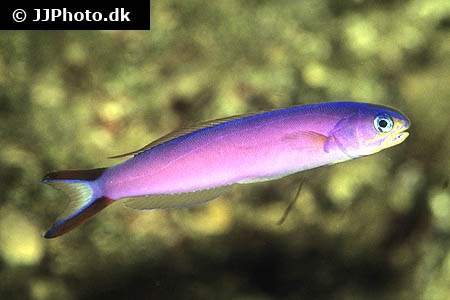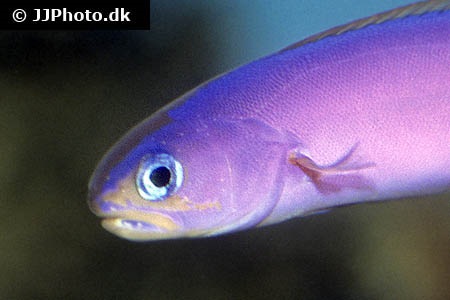Hoplolatilus purpureus


| Latin name | Hoplolatilus purpureus - Burgess, 1978 |
|---|---|
| Local name | Purple sand tilefish |
| Family | Malacanthidae - Hoplolatilus |
| Origin | Australia, Indonesia, Central/West Pacific |
| Max length | 13 cm (5.1") |
| Minimum volume |
400 l (106 gal) |
|---|---|
| Hardiness |
Delicate |
| Suitable for aquarium |
Experience, preparation and extra care required |
| Reef safe |
Always reef safe |
| Aggressiveness | Docile |
| Recommended |
Small crustaceans (Krill, mysis, artemia...) Zooplankton (Cyclops, pods...) |
|---|
This species is known to jump out of open aquaria.
This species demands a high water quality.
Amongst other things it means, that water must be properly oxygenated.
This species is easily susceptible to Marine Ich (Cryptocaryon irritants), when stressed by other fish, bad water quality, or when relocated.
This species is very sensitive during transportation and acclimatizing into the aquarium.
There is a greater chance of success with this species if one can supply a living feed to allow it to adapt to the tank.
Out in wild this species is used to faint light, so to acclimitize it, it is advantageous to dim the light at first and gradually increase it to normal.
This fish requires feeding several times a day, especially when newly added.
When the fish can find its natural food in the aquarium it requires less frequent feeding.
These fish prefer a substrate which allows it to burrow.
A substrate consisting of sand, coral pieces, shells and small pieces of broken up shells is ideal for them to dig holes in.
One can also arrange rocks to enable the fish to create a hole underneath, making certain they are secure and cannot fall over.
There should be space to enable them to make a hole which is at least 1½ inch (3 cm) longer than their own body.
Other animals digging in the sand, can stress this species, if the aquarium is not spacious enough. Be therefore aware of, for example of Wrasses which burrow at night.
This species thrives best in a pair. (Male and female)
This species revels in swimming and requires an aquarium with ample space.
This species is very shy and docile, so one should be careful when keeping it with more aggressive fish.
Tilefish (Malacanthidae) are delicate and can be challenging to keep, but it is possible if one ensures they have the correct surroundings.
These fish do not handle stress very well, therefore it is of importance to prepare the aquarium so the environment is optimal before buying the fish. Good hiding places which resemble their natural holes in sand/coral gravel, combined with stone holes are optimum. Plenty of swimming space is also vital!
Tilefish should not be kept together with semi aggressive and aggressive species, as they are very shy. Fish which can kept with Tilefishes are for example: Anthias, Jawfish, Roundheads, Dartfish, Cardinalfish, Dragonets and small peaceful Wrasses.
As these fish will swim around wildly if stressed, it is a good idea to avoid keeping them together with anemones, elegance corals etc.
Slightly subdued lighting is also preferable. Moonlight is also a good idea, as these fish will sometimes jump up out of the water which can cause injury.
Tilefish will sometime require live food in the beginning, but will often eat frozen food after a while. Some individuals also eat fish flakes, but do be aware they will primarily eat from the water column, and not what lies on the bottom of the tank. They do not thrive well if there is a lot of competion for food.
Normally these fish will be fine in coral aquaria, but will sometimes go after small shrimps, and on rare occasions, LPS.
Generally, there is a better chance of success with these fish, if multiple ones are kept. It is a good idea to have other peaceful fish which spend a lot of time at the water column.
They are rarely aggressive towards fellow species, but will sometimes chase very shy Wrasses for example.
When purchasing this fish, ensure that it is has been caught correctly, so the swim bladder is not damaged. The fish must be able to hold still in the water without having to make an effort to swim downwards.
| Aquarium trade | Yes |
|---|---|
| Distribution | Indo West Pacific: Philippines south to Indonesia east to Solomon Islands. |
| English common names |
Purple sand tilefish |
| Danish common names |
Purpur-teglfisk |
Henry C. Schultz. 2006. Redoing the Seafloor with Tile: The Subfamily Malacanthinae, Part I, Part II - Reefkeeping Magazine - (English)
Scott W. Michael. 2001. Basslets, Dottybacks & Hawkfishes: v. 2 (Reef Fishes) - TFH Publications / Microcosm Ltd. - (English)
Bob Fenner. Gorgeous, Intelligent, But Not Easy to Keep... The Sand Tilefishes, Family Malacanthidae - Wet Web Media - (English)

